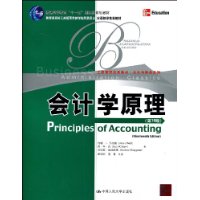约翰·J·怀尔德,威斯康星大学商学院教授。曾任教于密歇根州立大学和英国曼彻斯特大学。在大学部和研究所教授课程,曾获威斯康星大学2003年度毕业班教学卓越奖、密歇根州立大学教学卓越奖等。
崔学刚,中国人民大学管理学(会计学)博士、北京大学光华管理学院博士后、财政部全国会计学术带头人(后备)人才。现为北京工商大学MBA中心副主任、北京工商大学信息披露研究中心主任,兼任中国会计学会政府与非营利组织专业委员会委员、中国会计学会财务成本分会理事,两家股份公司独立董事。主要研究领域为会计与投资者保护、信息披露透明度及其经济后果等。在《会计研究》、《审计研究》、《中国会计评论》、Journal of International Financeand Economics等学术期刊发表论文40余篇,出版专著4部,主持国家社科基金与省部级课题多项。2005年获得北京市委组织部优秀人才资助项目,2005年被评为北京市中青年骨干教师,2008年获得北京市第十届哲学社会科学优秀成果奖二等奖。
饶菁,中国人民大学金融学学士,美国北伊利诺伊州立大学会计学硕士,北京大学光华管理学院在读博士。1998年美国伊利诺伊州注册会计师考试优胜奖.美国注册会计师协会会员(AICPA),回国前曾在美国普华永道国际会计公司从事管理咨询工作。目前任教于北京师范大学经济与管理学院.主要教授财务会计、审计、比较国际会计等课程。
插图:

The annual reporting period is not always a calendar year ending on December 31. Anorganization can adopt a fiscal year consisting of any 12 consecutive months. It is alsoacceptable to adopt an annual reporting period of 52 weeks. For example, Gap's fiscal yearconsistently ends the final week of January or the first week of February each year.
Companies with little seasonal variation in sales often choose the calendar year as their fis-cal year. For example, the financial statements of Marvel Enterprises (the company that con-trois characters such as Spider-Man, Fantastic Four, and Shang-Chi) reflect a fiscal year thatends on December 31. Companies experiencing seasonal variations in sales often choose anatural business year end, which is when sales activities are at their lowest level for the year.The natural business year for retailers such as Wal-Mart, Target, and Macy's usually endsaround January 31, after the holiday season.
Accrual Basis versus Cash Basis
After external transactions and events are recorded, several accounts still need adjustments be-fore their balances appear in financial statements. This need arises because internal transac-tions and events remain unrecorded. Accrual basis accounting uses the adjusting process torecognize revenues when earned and expenses when incurred (matched with revenues).
Cash basis accounting recognizes revenues when cash is received and records expenseswhen cash is paid. This means that cash basis net income for a period is the difference be-tween cash receipts and cash payments. Cash basis accounting is not consistent with generallyaccepted accounting principles.
It is commonly held that accrual accounting better reflects business performance than infor-mation about cash receipts and payments. Accrual accounting also increases the comparability offinancial statements from one period to another. Yet cash basis accounting is useful for severalbusiness decisions——which is the reason companies must report a statement of cash flows.
To see the difference between these two accounting systems, let's consider FastForward'sPrepaid Insurance account. FastForward paid $2,400 for 24 months of insurance coverage be-ginning on December 1, 2009. Accrual accounting requires that $100 of insurance expense bereported on December 2009's income statement. Another $1,200 of expense is reported in year2010, and the remaining $1,100 is reported as expense in the first 11 months of 2011. Exhibit3.2 illustrates this allocation of insurance cost across these three years. The accrual basis bal-ance sheet reports any unexpired premium as a Prepaid Insurance asset.

